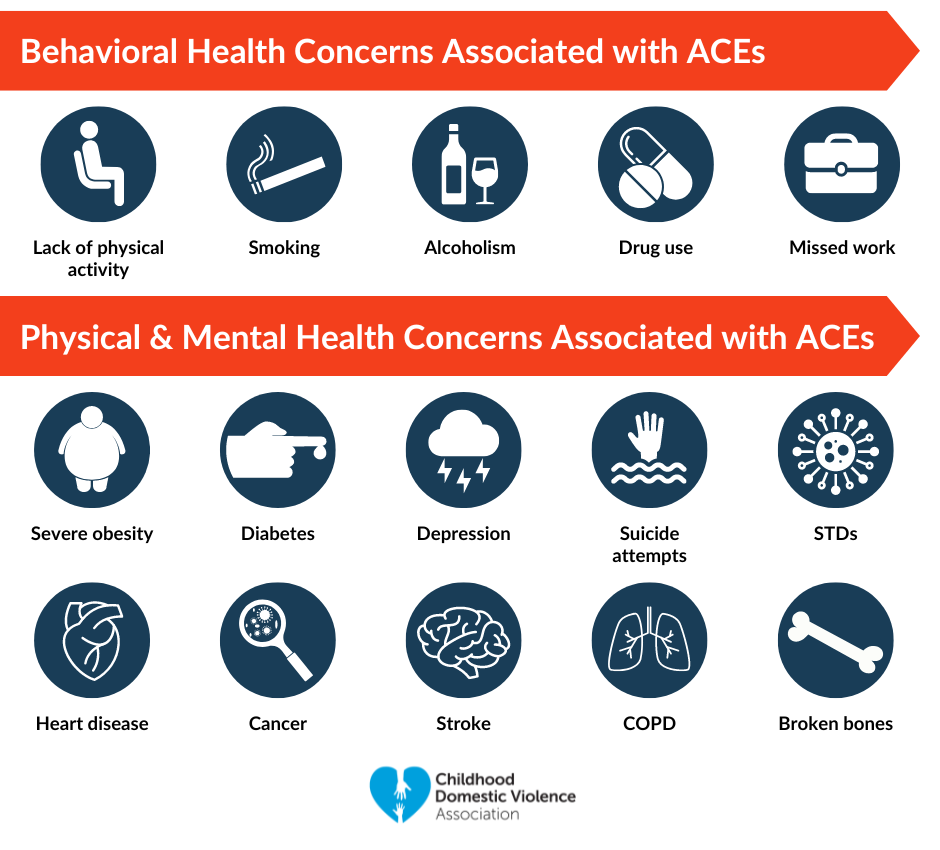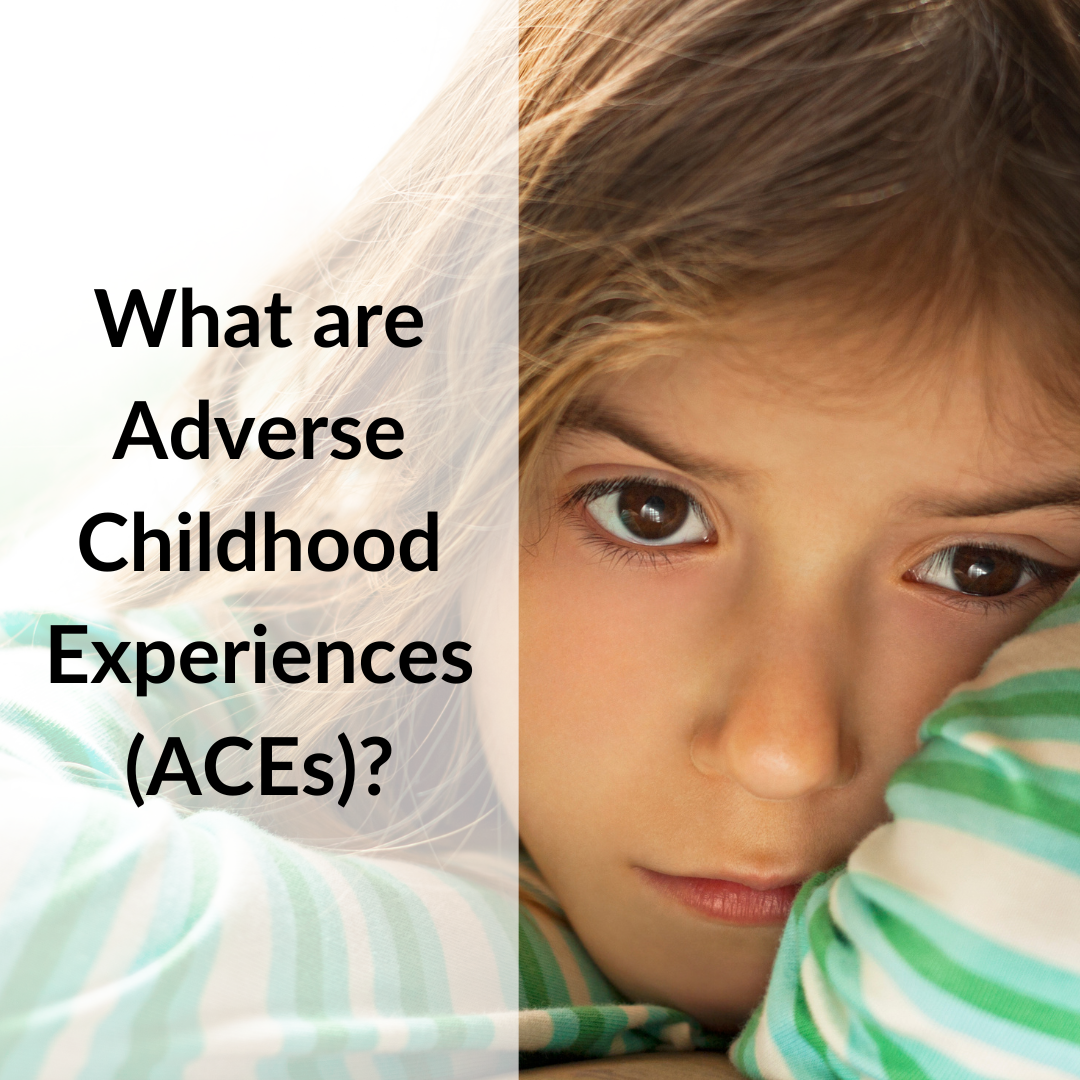What is an Adverse Childhood Experience, or ACE?
The term “Adverse Childhood Experiences” comes from the CDC-Kaiser Permanente Study, conducted from 1995 to 1997. The study originally began in an obesity clinic. As it grew, it started to uncover links between childhood trauma, chronic disease, and mental health issues.
It became the largest body of research to categorize 10 types of childhood trauma and understand the long-term impacts on health (see categories below). Recent research has gone on to include new focuses such as racism, bullying, community crime, foster care, homelessness, and immigration. CDV, or Childhood Domestic Violence, is one of these ACEs. Childhood domestic violence is defined as the experience of growing up in a home with domestic violence.
The 10 Adverse Childhood Experiences Are:
- Physical abuse
- Emotional abuse
- Sexual abuse
- Physical neglect
- Emotional neglect
- Alcohol or drug abuse by a parent
- Mentally ill parent
- Divorce
- Incarceration of a parent
- Childhood Domestic Violence
How Do Adverse Childhood Experiences (ACEs) Impact a Child’s Health and Well-being?
ACEs can impact all areas of a child’s life, leading to poor physical, mental, and behavioral outcomes into adulthood. Additionally, trauma from ACEs can also cause gastrointestinal, cardiovascular, musculoskeletal, respiratory, and dermatological symptoms.
The stress caused by ACEs can lead to chemical disruptions in the brain, hindering proper development. When a child lives in a constant state of fight-or-flight, the regular release of adrenaline and cortisol builds up into toxic stress. This process redirects more resources to the survival part of the brain. Furthermore, according to studies conducted by the CDC-Permanente Study, ACEs can even damage a child’s DNA and shorten their lifespan.
The Impacts of ACEs on the Brain and Body can Last Long Into Adulthood:

Multiple Adverse Childhood Experiences (ACEs) Compound the Impacts
ACE studies utilize ACE scoring, finding that the higher someone’s ACE score, the more childhood adversity they experienced. Consequently, this increases the likelihood of more negative impacts on physical and mental behavior and health.
ACE Studies discover that these ACEs impact lives and often co-occur—where there’s one adversity, there’s often more. According to researcher Jeff Edleson, more than 50% of those who experience an ACE also experience five or more other adversities.
Dr. Daniel Sumrok is a nationally recognized leader in the field of addiction science and addiction medicine, board-certified in family medicine and addictions, and the 2020-2022 president of the Tennessee Society of Addiction Medicine. Additionally, he is also very interested in Adverse Childhood Experiences (ACEs). In one of his blogs, he mentions some eye-opening statistics regarding the findings of the ACE study:
- Most people (64%) have at least one Adverse Childhood Experience (ACE).
- 87% of those with an ACE reported at least one other ace
- 50% of those with ACEs have three or more ACEs
- 12% of the population has an ACE score of 4.
- Having an ACE score of 4 nearly doubles the risk of heart disease and cancer.
- ACEs increase the likelihood of becoming an alcoholic by 700 percent and the risk of attempted suicide by 1200 percent.
Understanding Adverse Childhood Experiences (ACEs) Without Stigma
Adverse Childhood Experiences have massive societal consequences, but are often hidden from view. For instance, they are not understood by those who experience them. They are often not understood by parents or even misunderstood by the educational and medical systems. Adults may not make the connections to the adversities that have a direct impact on their lives, or may feel ashamed that they cannot simply move past or “get over” the feelings they still experience.
Fortunately, research shows that discussing it is one of the most effective ways to mitigate the impact of Adverse Childhood Experiences. Dr. Shanta Dube, Associate Professor at the School of Public Health at Georgia State University, was a member of the original team behind the CDC Kaiser-Permanente ACE study. While reviewing questionnaires, Dr. Dube encountered many participants thanking the study team for the questions they had asked. One said, “I thought I would die never having told anyone about my childhood.”
Adverse Childhood Experiences (ACEs) Awareness and Being THE ONE
Dr. Nadine Burke Harris, a pediatrician known for her work related to childhood trauma and a former California surgeon general, is a vocal advocate for the awareness of ACEs. She learned about the ACE Study in 2008:
“I was absolutely shocked that I had never heard about it and that as a doctor I was never trained on it…Ultimately, every pediatrician in America needs to screen for ACEs. For me, it’s no different than laying a stethoscope on a patient’s chest.”
She also emphasizes the importance of a caring adult who can, at a critical time, help foster resiliency in a child impacted by adversity. As Dr Burke Harris states, “One of the key ingredients for keeping the body’s stress response out of the toxic stress zone is the presence of a healthy buffering caregiver.”
Adverse Childhood Experiences (ACEs) have a profound impact on both society and individuals. Awareness and education of ACEs are critical. With greater awareness, better support systems can be established in the medical, educational, and social fields. This will ensure that children facing adversity can cope more successfully.
Through awareness, an adult can understand how to help a child facing adversity, or an adult still grappling with adverse childhood experiences can find the help and knowledge they need to rebuild their own path.
One of the key premises of our work here at CDVA centers around the buffering, healing, and transformative effects of THE ONE – a caring adult who steps in at a critical time to help foster the resiliency of a child impacted by adversity. Learn more about the Change A Life program, which in 50 minutes shows you how to be THE ONE for an at-risk child.
How CDV Fits Within the ACEs
Childhood exposure to domestic violence refers to growing up in a violent home. That violence can be physical, psychological, or emotional. The effects of witnessing domestic violence as a child can be profound, just like any other ACE. Most children who have experienced CDV have experienced at least one more, with many experiencing seven or more ACEs. Although undiagnosed childhood trauma can have profound physical and psychological effects, proper intervention can have an equally profound impact. This makes being THE ONE for an at-risk child all the more important, both for their health and for the health of society.

